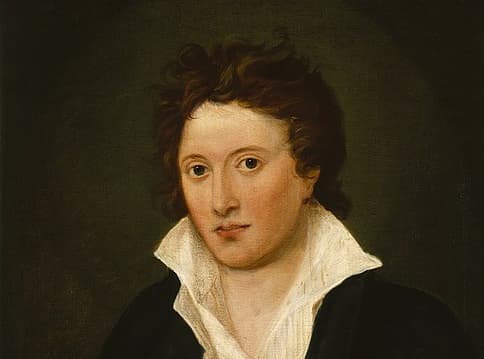Poem of the Day: ‘The Cold Earth Slept Below’
There is something premonitory about this poem, with its overt merging of winter imagery with that of decay and death.

Percy Bysshe Shelley (1792–1822) made a life, albeit a short one, out of a radical and utterly destructive utopianism. He was a dedicated atheist and a vegetarian, a proponent of property held in common. He felt that lovers, like property, should also be held in common, rather than being bound by the unhappy privatization of marriage. Despite his principled opposition to the institution of matrimony, he eloped to Scotland in 1811 with the sixteen-year-old Harriet Westbrook. Three years later, in a revision of that revision of his original principle, he ran away to France with Mary Godwin, the daughter of his mentor, William Godwin. She was also sixteen at the time.
For the rest of his life, he and Mary bounced between England and various points on the continent. Their household, composed of the Shelleys and their various sexual liasons, operated on a principle of evasion: of creditors, chiefly, but also of disapproving relatives and friends. Shelley had hoped to retain custody of his two children by Harriet, but they were remanded into foster care on grounds of his adultery and atheism. Three of his four children with Mary died before the age of five. By 1822, the year of his death by incompetence (in a boating accident off the Italian coast) Shelley’s utopian vision — free life, free love — had become the nightmare hallucination it always was.
Today’s poem, Shelley’s “The Cold Earth Slept Below” first appeared in print in 1815. There is something premonitory about this poem, with its shifts from tetrameter to dimeter, its abccaab rhymes, and its overt merging of winter imagery with that of decay and death. The dead woman, frozen into the landscape, might prefigure his first wife Harriet, who committed suicide by drowning in 1816. She might prefigure Mary, who came to regard her existence with Shelley as a life-in-death. Or she might point, in ways that the man himself could not consciously have admitted, to a life vision doomed to destroy everything it touched.
The Cold Earth Slept Below
by Percy Bysshe Shelley
The cold earth slept below;
Above the cold sky shone;
And all around,
With a chilling sound,
From caves of ice and fields of snow
The breath of night like death did flow
Beneath the sinking moon.
The wintry hedge was black;
The green grass was not seen;
The birds did rest
On the bare thorn’s breast,
Whose roots, beside the pathway track,
Had bound their folds o’er many a crack
Which the frost had made between.
Thine eyes glow’d in the glare
Of the moon’s dying light;
As a fen-fire’s beam
On a sluggish stream
Gleams dimly—so the moon shone there,
And it yellow’d the strings of thy tangled hair,
That shook in the wind of night.
The moon made thy lips pale, beloved;
The wind made thy bosom chill;
The night did shed
On thy dear head
Its frozen dew, and thou didst lie
Where the bitter breath of the naked sky
Might visit thee at will.
___________________________________________
With “Poem of the Day,” The New York Sun offers a daily portion of verse selected by Joseph Bottum with the help of the North Carolina poet Sally Thomas, the Sun’s associate poetry editor. Tied to the day, or the season, or just individual taste, the poems will be typically drawn from the lesser-known portion of the history of English verse. In the coming months we will be reaching out to contemporary poets for examples of current, primarily formalist work, to show that poetry can still serve as a delight to the ear, an instruction to the mind, and a tonic for the soul.
